
Tragedy and Turmoil: Nepal’s Gen Z Protests Against Corruption and Social Media Ban
In September 2025, Nepal witnessed one of its darkest chapters of civil unrest, marked by widespread protests from the youth—predominantly students—against pervasive government corruption and a controversial social media ban. The unrest tragically escalated into violence, resulting in at least 19 deaths and hundreds of injuries, exposing deep political fractures in the Himalayan nation.
The Spark: Social Media Ban and Corruption Outrage
The protests were ignited by the government’s abrupt ban on 26 popular social media platforms, including Facebook, X (formerly Twitter), YouTube, and WhatsApp. This ban, imposed on September 4, was officially justified by the government as a necessary step to regulate misinformation, hate speech, and online scams. However, critics argued it was a move to stifle dissent, especially as social media had become a powerful arena for youths to spotlight rampant nepotism and corruption among political elites. The ban stirred outrage primarily among Generation Z—the cohort born from the late 1990s to early 2010s—whose voices were rapidly gaining traction online.
Widespread Protests Led by Students
The ensuing protests, described as “Gen Z protests,” rapidly spread across Nepal’s major cities including the capital, Kathmandu. Tens of thousands of young demonstrators, many clad in school or college uniforms, took to the streets demanding the lifting of the social media ban and an end to the systemic corruption that many blamed for Nepal’s economic stagnation and lack of opportunity.
Protesters gathered near key government sites such as the Federal Parliament and Maitighar Mandala. Despite an indefinite curfew imposed by authorities, the youth defied restrictions, staging peaceful marches and chanting slogans calling for justice, transparency, and the resignation of corrupt officials.
Deadly Clashes and Loss of Young Lives
These peaceful protests turned violent on September 8, when security forces responded to demonstrators’ attempts to breach the parliament perimeter with tear gas, water cannons, rubber bullets, and live ammunition. Eyewitness accounts reported police firing indiscriminately, resulting in the deaths of 19 people, including many students. Hospitals admitted over 400 injured individuals, with many protestors suffering gunshot wounds. The killing of students shocked the nation and drew condemnation from numerous human rights organizations internationally.
Political Fallout and Aftermath
The violent crackdown led to swift political repercussions. Nepal’s Home Minister Ramesh Lekhak resigned, taking moral responsibility for the bloodshed. Two other ministers—agriculture and water—also stepped down amid mounting pressure. The government lifted the social media ban the day following the protests, attempting to quell the unrest.
International bodies like the United Nations and Amnesty International called for transparent investigations into the police’s use of lethal force. The National Human Rights Commission of Nepal similarly urged restraint and accountability from security forces.
The Bigger Picture: Corruption and Youth Frustration
At the heart of these protests lies a profound youth frustration with endemic corruption and nepotism in Nepal’s political system, which they believe blocks economic progress and undermines democratic freedoms. The government’s attempt to regulate social media was seen as an authoritarian move to silence this dissent rather than address substantive issues.
With personal remittances making up over a third of Nepal’s GDP, the youth feel the acute sting of economic hardships and a lack of future opportunities. The protests not only highlight the desire for freedom of expression but also the urgent need for political reforms that can rebuild trust between the government and its youngest citizens.
This blog outlines the core issues behind Nepal’s 2025 Gen Z protests, the tragic losses of students killed by government forces, and the ongoing struggle against corruption in the country protests e: Nepali Congress office, leaders’.
